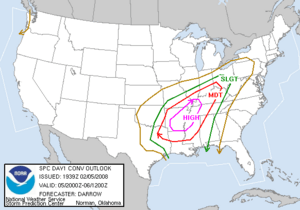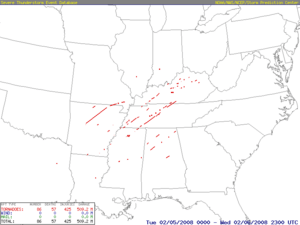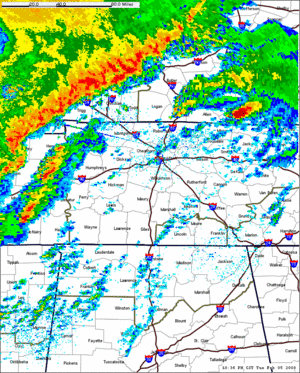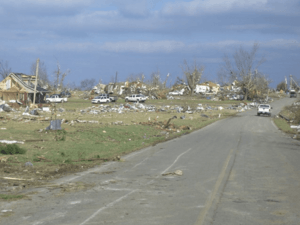2008 Super Tuesday tornado outbreak facts for kids
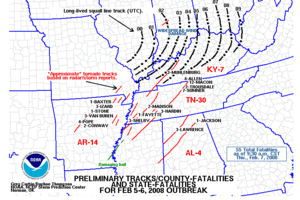
Map of reported tornadoes (tornadoes in red)
|
|
| Type | Tornado outbreak |
|---|---|
| Duration | February 5–6, 2008 |
| Tornadoes confirmed | 87 confirmed (Record for a tornado outbreak in February) |
| Max rating1 | EF4 tornado |
| Duration of tornado outbreak2 | 15 hours, 20 minutes |
| Damage | $1.2 billion (2008 USD) |
| Areas affected | Southern United States, Lower Ohio River Valley |
| 1Most severe tornado damage; see Enhanced Fujita scale 2Time from first tornado to last tornado | |
The 2008 Super Tuesday tornado outbreak was a very strong and deadly series of tornadoes. It hit the Southern United States and the lower Ohio Valley on February 5 and 6, 2008. This event started on a day called Super Tuesday.
On Super Tuesday, many states hold important elections to choose who will run for president. States like Missouri, Illinois, Arkansas, Alabama, and Tennessee were holding their elections when the storms hit. Some places where people voted had to close early because of the dangerous weather.
During this outbreak, 87 tornadoes formed over 15 hours. They started in the afternoon of February 5 and lasted until the early morning of February 6. Some of these tornadoes caused a lot of damage in busy areas. This included the Memphis metropolitan area, Jackson, Tennessee, and the area around Nashville.
Sadly, 57 people lost their lives across four states. Hundreds more were hurt. At the time, this was the deadliest tornado outbreak since modern radar systems (called NEXRAD) were fully used in 1997. The total damage from the tornadoes was estimated to be over $500 million.
The same weather system also caused other problems. There were strong winds, hail as big as softballs (about 4.5 inches wide), major floods, and heavy snow. The total damage from all these weather events reached $1.2 billion.
How the Storms Formed
Before the tornadoes, warm air moved into the southern Great Plains on February 4 and 5. Temperatures reached 70-80°F (21–27 °C) in many areas. This warm, moist air helped create the conditions for severe storms.
A strong cold front then moved in from the west. When this cold front met the warm, moist air, it created a lot of wind shear. This means winds at different heights were blowing in different directions. This kind of wind pattern is perfect for creating rotating thunderstorms called supercells. These supercells can produce powerful tornadoes.
The Storm Prediction Center (SPC) warned people about the severe weather. On February 5, they issued a "high risk" warning for most of Arkansas. This was the first time they had issued such a high warning in February since 1998. The warning area later grew to include parts of Kentucky, Mississippi, Missouri, Tennessee, and Illinois.
Tornadoes Begin
In the late afternoon of February 5, many supercell thunderstorms quickly formed. The first tornadoes touched down around 3:30 pm CST. Some of the strongest supercells hit the Memphis and Jackson areas. One tornado traveled an amazing 122 miles (196 km) and lasted for about two hours!
As the evening went on, more tornadoes were reported. One supercell moved across Middle Tennessee, including the Nashville area, and into south-central Kentucky. Several deadly tornadoes hit these areas between 7:30 pm and 11:00 pm CST.
A special warning called a "tornado emergency" was issued five times on February 5. This type of warning means a large, deadly tornado is happening or is about to happen. Four of these warnings were for Tennessee, and one was for Alabama.
Storms Continue East
On February 6, the storm system moved eastward. More tornadoes touched down in Alabama early in the morning. After that, the main danger became strong winds across the eastern United States. No more tornadoes were reported as the cold front moved out to the Atlantic Ocean.
Farther north, the same weather system brought heavy snow and freezing rain. This happened from Iowa all the way to Quebec, Canada.
Tornadoes Confirmed
A total of 87 tornadoes were confirmed during this outbreak. Five of them were rated EF4, which means they caused incredible damage.
| EFU | EF0 | EF1 | EF2 | EF3 | EF4 | EF5 | Total |
|---|---|---|---|---|---|---|---|
| 0 | 31 | 30 | 16 | 5 | 5 | 0 | 87 |
Arkansas's Longest Tornado Track
| EF4 tornado | |
|---|---|

EF4 damage to a house in Clinton, Arkansas
|
|
| Max rating1 | EF4 tornado |
| Damage | $119.31 million (2008 USD) |
| 1Most severe tornado damage; see Enhanced Fujita scale | |
The first long-lasting supercell created a tornado that traveled for 122 miles (196 km). This was the longest single tornado track ever recorded in Arkansas since 1950. It touched down around 4:50 pm CST.
The tornado quickly grew stronger, reaching EF3 strength. It hit Lucky Landing, a marina at Lake Atkins, destroying boats and mobile homes. One person was killed there. The tornado then hit the edge of Atkins, killing three more people. Many homes were destroyed or badly damaged.
As it moved into Conway County, it was still an EF3. It destroyed chicken houses, killing 80,000 chickens. An elderly couple died when their mobile home was completely swept away.
EF4 Damage in Arkansas
The tornado became even stronger, reaching EF4 intensity, as it entered Van Buren County. It tore through the southern part of Clinton, killing three people. A boat factory was completely flattened, and homes were swept from their foundations. Cars were twisted around trees.
The tornado stayed at EF4 strength as it hit Mountain View. The local hospital was badly damaged, and a car dealership was completely flattened. One car was thrown a long distance over a building. One person died when their house was swept away.
It then weakened slightly to a strong EF3 as it hit Zion in Izard County, killing two people. Many homes were destroyed, and hundreds of cattle were killed. A Jeep was stripped down to its frame and wrapped around a tree stump.
The tornado continued as an EF3 into Sharp County, hitting Highland. Many businesses were damaged or destroyed, and the fire station was ruined. The tornado then weakened and ended.
In total, this single tornado killed 13 people and injured 140. It destroyed at least 200 homes and businesses. The damage was estimated at nearly $120 million.
Memphis, Tennessee Tornado
| EF2 tornado | |
|---|---|
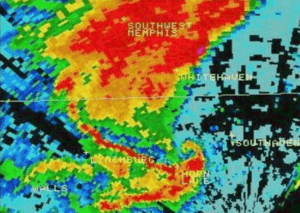
Radar view of the supercell that caused the Southaven/Memphis tornado.
|
|
| Max rating1 | EF2 tornado |
| Damage | $128.4 million (2008 USD) |
| Power outages | 65,000 |
| 1Most severe tornado damage; see Enhanced Fujita scale | |
At 5:32 pm CST, a supercell thunderstorm created a tornado in Southaven, Mississippi. It caused minor damage at Southaven High School. The tornado quickly became an EF2, destroying three warehouse buildings.
The tornado then crossed into Memphis, still at EF2 strength. Live TV showed the tornado moving through the city. The National Weather Service issued a "tornado emergency" for Memphis.
The tornado caused a lot of damage at Memphis International Airport. A hangar lost its roof, and planes were moved around. A Boeing 737 aircraft was moved one foot! FedEx services were delayed because of the damage.
A warehouse was destroyed, killing three people inside. The tornado also damaged the Hickory Ridge Mall, causing a large wall and part of the roof to collapse at the Sears store. Six people were injured at the mall. Many trees and power poles were snapped, and about 65,000 homes lost power.
This tornado was rated EF2. It killed three people and injured 13.
Jackson, Tennessee Tornadoes
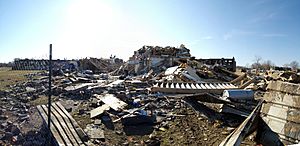
EF4 damage to dormitory buildings at Union University in Jackson, Tennessee.
|
|
| Tornadoes confirmed | 2 |
|---|---|
| Max rating1 | EF4 tornado |
| Damage | $110.3 million (2008 USD) |
| 1Most severe tornado damage; see Fujita scale | |
Another powerful tornado touched down near Yum Yum in Fayette County, Tennessee. It quickly reached EF3 strength. A man was killed when his pickup truck was thrown 40 feet.
The tornado then hit Dancyville, damaging homes and a church. It continued to Hillville, destroying mobile homes. It regained EF3 strength as it hit Huntersville, where two people were killed. A church bus was tossed hundreds of feet.
The tornado then headed towards Jackson. It blew cars and 13 tractor-trailers off Interstate 40. It weakened and lifted just before reaching the busy parts of Jackson.
Second Tornado in Jackson
Soon after the first tornado ended, a new, very strong tornado formed. This new tornado touched down at the Union University campus in Jackson. It immediately became a violent EF4 tornado, causing huge damage.
Several large, brick dormitory buildings were badly damaged, and two completely collapsed. About 80% of the dorms were damaged or destroyed. Hundreds of cars were also damaged. Twelve students were trapped but were rescued. The university had to close for almost two weeks.
The tornado then weakened slightly to EF3 strength. It damaged banks, businesses, a hospital, and doctors' offices. It moved through northern Jackson, damaging many homes in neighborhoods like Chapel Creek and Indian Hills. The Madison County Fire Station #11 was also destroyed.
Even though this tornado caused EF4 damage in a busy area at night, no one died in Jackson. However, 51 people were injured. The first EF3 tornado killed three people and injured 14. This was the third violent tornado to hit Jackson in 10 years.
The tornadoes caused about $47 million in damage in Madison County. Union University alone had $40 million in damage.
Castalian Springs–Lafayette, Tennessee/Tompkinsville, Kentucky Tornado
| EF3 tornado | |
|---|---|
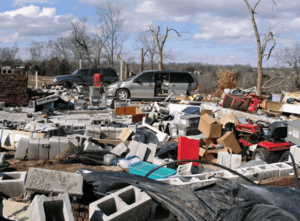
EF3 damage to a home in Castalian Springs, Tennessee.
|
|
| Max rating1 | EF3 tornado |
| Damage | $28.802 million (2008 USD) |
| 1Most severe tornado damage; see Enhanced Fujita scale | |
After 9:00 pm CST, a supercell that had caused tornadoes earlier moved over Nashville. Luckily, no tornadoes were reported in Nashville itself. Fans at a hockey game in the city were not allowed to leave the arena until the storm passed.
After leaving Nashville, the supercell created a devastating EF3 tornado. This tornado touched down southwest of Castalian Springs just after 10:00 pm CST. It became the deadliest tornado of the outbreak, killing 22 people.
The tornado quickly became an EF3 as it tore through Castalian Springs. It destroyed many homes and businesses. The post office was leveled, and mobile homes were obliterated. The historic Wynnewood Inn was also badly damaged.
An 11-month-old baby, Kyson Stowell, survived being thrown from his family's destroyed home. He was found unharmed nearly 500 feet away. Sadly, his mother was killed. Seven people died in Castalian Springs, and 14 were injured.
Damage in Trousdale and Macon Counties
The tornado then moved into Trousdale County, weakening slightly to a strong EF2. Homes were damaged, cars were tossed, and trees were snapped. A natural gas plant was ripped apart, causing a major fire. Two people were killed in this county, and five were injured.
Crossing into Macon County, the tornado regained EF3 strength. It hit the western and northern parts of Lafayette, causing widespread destruction. Many homes and churches were destroyed, some leveled to the ground.
Thirteen people were killed in and around Lafayette, and 44 were injured. President George W. Bush visited the area to see the damage. Debris from Lafayette was found 70 miles (110 km) away in Kentucky. About 260 houses in these three Tennessee counties were destroyed.
Into Kentucky
The tornado continued into Monroe County, Kentucky as an EF3. It destroyed homes and mobile homes near Gamaliel. Thirteen people survived by taking shelter in a basement. The tornado then clipped the northern edge of Tompkinsville, destroying a warehouse and damaging other buildings.
The tornado then weakened and lifted in Cumberland County. It caused no injuries or deaths in Kentucky. The total path of this tornado was 50.32 miles (81.0 km) long and up to 880 yards (800 m) wide. The Governor of Tennessee said the area looked like "the Lord took a Brillo pad and scrubbed the ground."
Moulton–Decatur, Alabama Tornado
| EF4 tornado | |
|---|---|

EF4 damage to a house near Moulton, Alabama.
|
|
| Max rating1 | EF4 tornado |
| Damage | Unknown |
| 1Most severe tornado damage; see Enhanced Fujita scale | |
Around 1:00 am CST, a line of storms moved into Alabama. A supercell formed and spawned a tornado in Lawrence County, Alabama, at 3:02 am CST. The tornado touched down south of Moulton.
Many houses were damaged or destroyed, and a church was leveled. Three people from the same family were killed north of Aldridge Grove. A large brick home was completely leveled, and a truck was thrown over 100 yards. An elderly woman was also killed in her mobile home. In total, four people died and 23 were injured.
This tornado was first called an EF3 but was later upgraded to an EF4. The hardest hit areas were Wren, Speake, Pin Hook, and Five Points. The tornado lifted before reaching Decatur.
Other Weather Events
The cold front also caused many reports of damaging winds. Wind gusts reached over 50 mph (80 km/h) from Arkansas to Indiana. This brought down many trees and power lines, causing widespread power outages. A wind gust of 82 mph (131 km/h) was recorded in Terre Haute, Indiana.
Hail as large as softballs (4.5 inches wide) was reported in several places. In Canada, early thunderstorms brought heavy rain to parts of southern Ontario.
Flooding
Heavy rains from February 4 to 6, along with melting snow, caused flooding. This happened in parts of Illinois, New York, Kentucky, Indiana, and Ohio. Rivers and streams overflowed, especially in the Miami Valley and around Findlay. Several streets in Fort Wayne were underwater.
Winter Storm
The same weather system that caused the tornadoes also brought a big snowstorm. It hit from the Central Plains to the western Great Lakes. Some areas in Wisconsin received 18 to 21 inches (45–53 cm) of snow. In Michigan, up to 14 inches (35 cm) of snow fell.
In southern Ontario, Canada, some areas received almost 1 inch (25 mm) of freezing rain. Toronto had two waves of heavy snow with thunder and lightning, bringing up to 14 inches (35 cm) of winter precipitation.
Over 1,000 flights were canceled at Chicago's O'Hare International Airport. Milwaukee's airport also briefly shut down due to heavy snow. Near Madison, Wisconsin, about 1,000 cars were stuck on Interstate 90. The Governor of Wisconsin declared a state of emergency. This winter storm caused at least four deaths.
Aftermath and Help
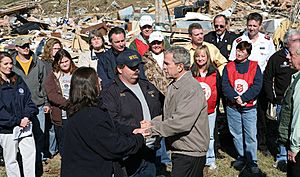
On February 7, President George W. Bush declared 11 counties in Arkansas and five counties in Tennessee as federal disaster areas. This meant these areas could get special government help. President Bush also visited Tennessee on February 8 to see the damage.
Groups like the American Red Cross, the Salvation Army, and the United Way quickly sent volunteers. They helped people affected by the storms. In the hardest-hit areas of Middle Tennessee, the Red Cross sent over 100 volunteers to deliver food and supplies.
The Nashville Predators hockey team donated half of their ticket sales revenue from a game to the American Red Cross. Fans could also give extra donations. The National Football League's Tennessee Titans also organized a donation drive to help victims.
|


